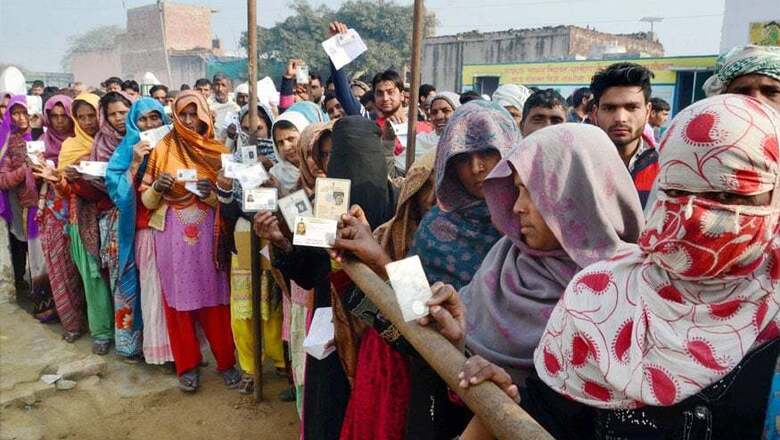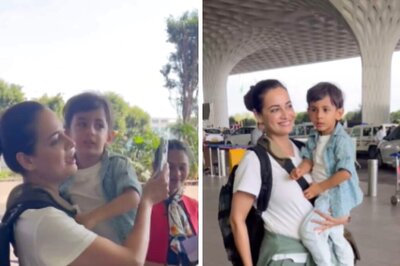
views
New Delhi: The fate of 721 candidates in the electoral fray were sealed on Tuesday as 2.28 crore voters in 11 districts of Uttar Pradesh voted in the second phase of the 2017 Assembly elections.
Polling began at 7 am on Tuesday and lines were closed at 5 pm. The Election Commission, during a press conference, said that the turnout at 5 pm was recorded at 65.5%. The districts that went to polls in the second phase outperformed those from the first phase, which recorded a turnout of 64.4%.
Over 23,000 polling booths were set up across Saharanpur, Bijnor, Moradabad, Sambhal, Rampur, Bareilly, Amroha, Pilibhit, Lakhimpur Kheri, Shahjahanpur and Badaun districts of UP. Drugs worth Rs. 1.16 crore and alcohol worth Rs 9 crore were seized. There were reports of EVMs malfunctioning in some parts of the state, which led to minor delays in voting.
Several heavyweights were in the fray in the second phase and the most high-profile name on the list was that of UP cabinet minister and senior Samajwadi Party leader Mohammed Azam Khan, who is contesting from his bastion in Rampur. Khan, a three-time MLA from Rampur, also ensured that his son Mohammed Abdullah Khan received the SP ticket from Suar Tanda constituency in the same district, where he will take on three-time MLA Nawab Kazim Ali Khan.
In Saharanpur district, the Congress will be hoping to pack a punch on the back of UP Congress Committee Vice-President Imran Masood’s popularity. Masood, who had courted controversy in 2014 by making controversial remarks against then Prime Ministerial candidate Narendra Modi, is contesting from the Nakur Assembly seat. He had also contested the 2014 Lok Sabha elections and lost by a slim margin to BJP’s Raghav Lakhanpal. Masood will take on Dharam Singh Saini, who quit the BJP last year and is contesting on a BJP ticket. Saharanpur district, given its high concentration of both Dalits and Muslims, will be a litmus test for the social engineering experiment of the Bahujan Samaj Party. Of all the districts that have gone to polls so far, Saharanpur has recorded the highest turnout at nearly 72%.
Communal tensions in Bijnor cast their shadow on the polls in the district, where a 17-year-old was allegedly murdered by members of another community just five days before the polls. For the second time in less than six months, the twin villages of Peda and Nayagaon, both on the outskirts of Bijnor, were on the edge with communal tensions rising. Late on Friday, Sanjay Singh and his son had gone to water the fields when a dozen men, allegedly belonging to another community, attacked them with knives and guns. The son, 17-year-old Vishal Kumar, was killed in the attack while trying to protect his father.
Most of the constituencies that went to polls on Tuesday are considered Samajwadi Party bastions. Analysts say the second phase was the SP’s game to lose. “Phase 2 was largely conducted in the Rohilkhand region, which is the SP’s stronghold in terms of regional distribution of support base. So, high support for the SP shouldn't be very surprising. The next phase is important for the BJP as it needs to perform well on urban seats in Kanpur and Lucknow to remain in the contest,” said Pranav Gupta of Lokniti-CSDS.
He added that the BSP’s social engineering experiment may not yield the results that the Mayawati-led party is hoping for. “The Dalit-Muslim alliance of the BSP was non-starter if one goes by evidence from pre-poll surveys. Despite a string of endorsements from religious leaders, it is difficult to imagine why that would have changed.”
Some of the districts that recorded high turnouts also co-incidentally have a higher concentration of Muslim voters. Saharanpur district, for example, has around 42% Muslims. Amroha, which recorded around 69% turnout, has around 41% Muslims. Gupta, however, said it is impossible to tell from turnout figures alone which way voters will swing. “Too much shouldn't be read into high turnout as research on electoral data doesn't show any clear relationship between incumbency and turnout.”




















Comments
0 comment